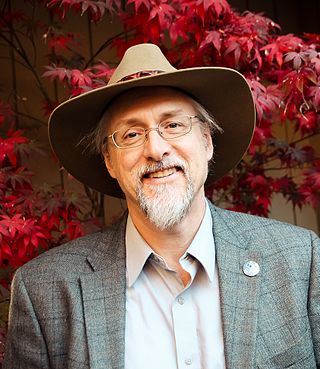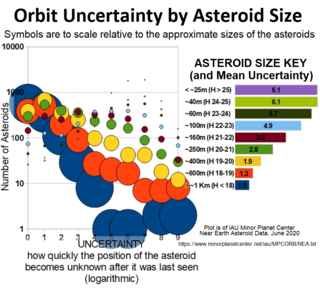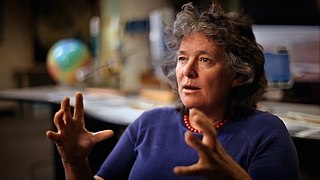Related Research Articles

The Ames Research Center (ARC), also known as NASA Ames, is a major NASA research center at Moffett Federal Airfield in California's Silicon Valley. It was founded in 1939 as the second National Advisory Committee for Aeronautics (NACA) laboratory. That agency was dissolved and its assets and personnel transferred to the newly created National Aeronautics and Space Administration (NASA) on October 1, 1958. NASA Ames is named in honor of Joseph Sweetman Ames, a physicist and one of the founding members of NACA. At last estimate NASA Ames had over US$3 billion in capital equipment, 2,300 research personnel and a US$860 million annual budget.
The Minor Planet Center (MPC) is the official body for observing and reporting on minor planets under the auspices of the International Astronomical Union (IAU). Founded in 1947, it operates at the Smithsonian Astrophysical Observatory.

Eleanor Francis "Glo" Helin was an American astronomer. She was principal investigator of the Near-Earth Asteroid Tracking (NEAT) program of NASA's Jet Propulsion Laboratory.

Catalina Sky Survey is an astronomical survey to discover comets and asteroids. It is conducted at the Steward Observatory's Catalina Station, located near Tucson, Arizona, in the United States.
Brian A. Skiff is an American astronomer noted for discovering numerous asteroids and a number of comets including the periodic comets 114P/Wiseman–Skiff and 140P/Bowell–Skiff.

Richard Alan Searfoss was an American aviator who was United States Air Force colonel, NASA astronaut and test pilot.

Marc William Buie is an American astronomer and prolific discoverer of minor planets who works at the Southwest Research Institute in Boulder, Colorado in the Space Science Department. Formerly he worked at the Lowell Observatory in Flagstaff, Arizona, and was the Sentinel Space Telescope Mission Scientist for the B612 Foundation, which is dedicated to protecting Earth from asteroid impact events.
Loren C. Ball is an American amateur astronomer, who has discovered more than 100 asteroids while working at his Emerald Lane Observatory (843), built on the roof of his house on Emerald Lane, Decatur, Alabama. As of 2021, he has credit for 108 numbered designations with the Minor Planet Center at Harvard for the period between 2000 and 2004. None of them were co-discoveries. He is under contract with NASA through the University of Alabama in Huntsville to do outreach to school groups and organisations. As of 2019, he promotes asteroid education in schools and on social media.

Leonid Kostyantynovych Kadenyuk was the first astronaut of independent Ukraine who flew into outer space. He flew on NASA's Space Shuttle Columbia in 1997 as part of the international mission STS-87. Kadenyuk held the rank of major general in the Ukrainian Air Force. He was Deputy of Ukraine of the 4th convocation, People's Ambassador of Ukraine, Hero of Ukraine, President of the Aerospace Society of Ukraine, Adviser to the Prime Minister of Ukraine and Chairman of the State Space Agency of Ukraine, Honorary Doctor of Chernivtsi National University.
George Wetherill was a physicist and geologist and the director emeritus of the department of terrestrial magnetism at the Carnegie Institution of Washington, DC, US.
Jon F. Claerbout is an American geophysicist and seismologist. He is the Cecil Green Professor Emeritus of Geophysics at Stanford University. Since the later half of the 20th century, he has been a leading researcher and pioneered the use of computers in processing and filtering seismic exploration data, eventually developing the field of time series analysis and seismic interferometry, modelling the propagation of seismic waves.

Amy Mainzer is an American astronomer, specializing in astrophysical instrumentation and infrared astronomy. She is the deputy project scientist for the Wide-field Infrared Survey Explorer and the principal investigator for the NEOWISE project to study minor planets and the Near Earth Object Surveyor space telescope mission.

Takuya Onishi is a Japanese astronaut selected for the Japan Aerospace Exploration Agency (JAXA) in 2009. He spent four months on board the International Space Station in 2016.
Harold James Reitsema is an American astronomer who was part of the teams that discovered Larissa, the fifth of Neptune's known moons, and Telesto, Saturn's thirteenth moon. Reitsema and his colleagues discovered the moons through ground-based telescopic observations. Using a coronagraphic imaging system with one of the first charge-coupled devices available for astronomical use, they first observed Telesto on April 8, 1980, just two months after being one of the first groups to observe Janus, also a moon of Saturn. Reitsema, as part of a different team of astronomers, observed Larissa on May 24, 1981, by watching the occultation of a star by the Neptune system.

The uncertainty parameterU is introduced by the Minor Planet Center (MPC) to quantify the uncertainty of a perturbed orbital solution for a minor planet. The parameter is a logarithmic scale from 0 to 9 that measures the anticipated longitudinal uncertainty in the minor planet's mean anomaly after 10 years. The larger the number, the larger the uncertainty. The uncertainty parameter is also known as condition code in JPL's Small-Body Database Browser. The U value should not be used as a predictor for the uncertainty in the future motion of near-Earth objects.

Frances "Fran" Bagenal is a Professor of Astrophysical and Planetary Sciences at the University of Colorado Boulder and a researcher in the fields of space plasmas and planetary magnetospheres.
Lisa Hardaway (1966–2017) was an American aerospace engineer and program manager for an instrument on the New Horizons spacecraft to Pluto and Beyond. Among her awards, she was named Engineer of the Year for 2015–2016 by the Colorado American Institute of Aeronautics and Astronautics.
Norman H. Sleep is an American geophysicist and professor of geophysics at Stanford University. He has done internationally recognized research on plate tectonics and many other areas of geology and planetology.
References
- 1 2 "7860 Zahnle (1980 PF)". Minor Planet Center. Retrieved 25 February 2019.
- ↑ "Kevin Zahnle". NASA Ames Research Center. 19 March 2018. Retrieved 15 October 2019.
- ↑ "MPC/MPO/MPS Archive". Minor Planet Center. Retrieved 25 February 2019.